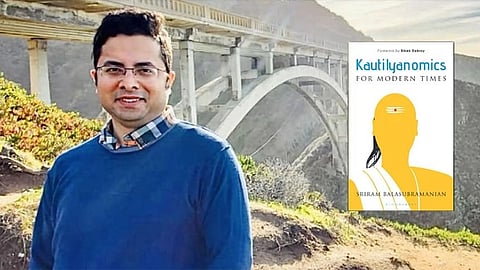

The Nehru Centre London staged the launch of Author and Economist Sriram Balasubramanian’s latest publishing titled ‘Kautilyanomics For Modern Times’. In conversation with Economist and Member of the Economic Advisory Council to the Prime Minister of India Sanjeev Sanyal, the author addresses the economic contours of his book.
Diving into the particulars
Sriram narrates: “I was working on Angus Maddison’s dataset many years ago. In that India and China have been the top countries from the common era till 17th century. My understanding was that there is an economic framework here which formed a base for this growth.”
Analysing the ‘Arthashastra’, an ancient Indian scripture written by Chanakya or Kautilya, Indian scholar and advisor to the Mauryan Emperor Chandragupta Maurya, Sriram understood that through governance, the topics of currency issuance and taxation were also discussed.
While researching on pre-existing evidence, Sriram realised that most books based on the Arthashastra were focused on the political and strategic or motivational aspects rather than the economic and financial nature of Kautilya’s work.
Triggered by the lack of literature, Sriram was determined to produce an economics edition of the Kautilya’s thinking and contextualising it to current times to encourage debates and discussions.
MORE LIKE THIS…
Dharmic way
The economist summarises the five Kautilyan principles of sustainable development that prevailed in India into: dharma, attributable to economic and social wellbeing; governance or citizen responsibilities; wealth creation; market facilitation and institutional capacity of taxation and money creation.
He enlightens us, “the dharmic way of life was the base of the sustainable way of growth model.”
Opening readers to the materialistic angle of normal life that existed in all earlier texts along with the spiritual angle, Sriram draws examples from the Arthashastra.
He says that according to Kautilya, governance requires four fields of knowledge: law; economic policy; philosophy; cultural context.
Looking at other civilisations, Sriram goes on to add, “the Japanese have their own version of stakeholder capitalism and the Chinese use some of their ancient economical concepts even today.”
Challenges overcome
“I had to work with Sanskrit scholars to go through the texts.”
Sriram picked out areas where economics was discussed and integrated these with economic and financial frameworks.
Getting a publisher is a difficult task states as he mentions that “Bloomsbury saw a vision for the book.”
For incorporating new frameworks, Sriram had to cross check with economists and Sanskrit scholars to make sure these were aligned.
MORE LIKE THIS…
Modern day integration
“I was a bit reluctant to get the dharmic capitalism quotation into the framework because I believe it has its own indigenous flavour to it.”
According to Kautilya, dharma plays the role of a self-correcting mechanism. Sriram explains, “he believed that individual actions determine economic outcomes at an aggregate level whether it is the state or the market.”
“We talk about societal and environmental responsibilities which are triggered by dharmic consciousness.” Sriram says that Kautilya would have recognised the behavioural problem behind climate change.
On an endnote, the author explains that Kautilya was a political economist who understood the wants of the society. He quotes, “King’s happiness lies in the happiness of his subjects, welfare in the welfare of his subjects.”
*Info: Nehru Centre London